Having toilet issues in an RV can be extremely inconvenient and frustrating. If the toilet water won’t properly drain out of the holding tank, it prevents being able to use the facilities until the problem is addressed. This article will cover the common causes of clogged RV toilets, how to diagnose the specific issue, solutions for unclogging, preventative measures to avoid frequent clogs, and answer some common questions related to RV toilet maintenance.
Clogged RV toilet drain lines that prevent water from properly emptying from the holding tank are a fairly common issue for recreational vehicle owners. Generally, there is some type of blockage along the drainage path – either at the toilet itself where waste enters, along the pipeline, or at the output valve where waste exits the vehicle. Diagnosing the exact location and cause of the clog is key to being able to address it. Clearing the obstructed drainage line can often be done without professional help using basic tools and methods. Taking preventative measures, like using RV toilet paper and discharge valves regularly, can also reduce the occurrence of clogs.
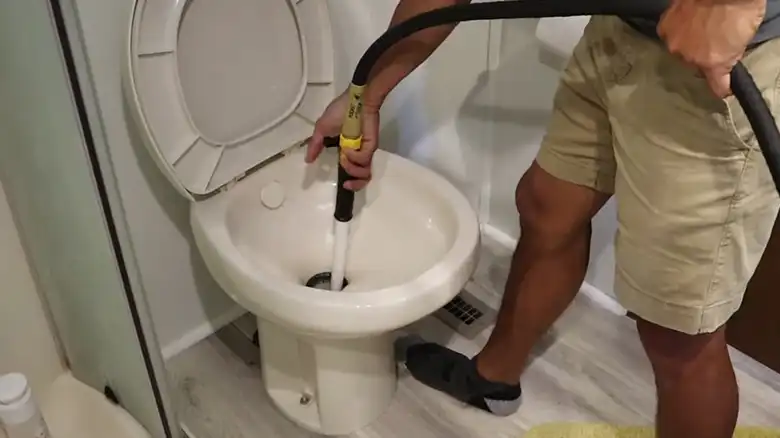
Diagnosing Clogged RV Toilet Problems
When an RV toilet fails to drain properly, the first step is determining why the water is not exiting the holding tank correctly. There are a few main possibilities:
Water doesn’t drain initially – Clogged at inlet/outlet: If no water is draining at all when the toilet is flushed, the clog is likely at either the inlet where waste enters or the output valve where water exits the tank. Common clogs at the inlet are from too much toilet paper or non-dissolving paper products. Output valve clogs typically involve more solid waste blocking the exit. Diagnosis is confirmed by checking these locations before the tank.
Water drains slowly – Partial clog lowering flow: If water and waste do drain from the tank, but at a slower rate than usual, there is likely a partial clog along the drainage pipe system. This allows some flow but reduces it via displaced waste buildup along the pipes. Checking connections and pipe condition is needed to isolate the problematic area(s).
Water drains then backs up – Mid-line clog allowing some drainage first: In some cases, water will initially drain as expected, but then back up and fail to exit the tank completely after multiple flushes. This points to a clog that forms mid-way in the drainage line, not immediately blocking flow but accumulating waste over time until it obstructs full drainage. Inspection of drainage plumbing layout is required to pinpoint potential clog locations.
Must-Have Products for Unclogging Your RV Toilet
If you’ve faced a stubborn clog in your RV toilet, there are effective solutions beyond the standard plunger. Let’s discuss some recommended accessories to keep your RV’s sewer system running smoothly.
Drainers for Septic Tanks: When faced with a clogged RV toilet, a reliable black tank cleaner is your go-to option for clearing blockages. Chemical-based remedies are quick and efficient solutions to tackle toilet clogs in your recreational vehicle. It’s crucial for every RV camper to be acquainted with these products before embarking on their journeys.
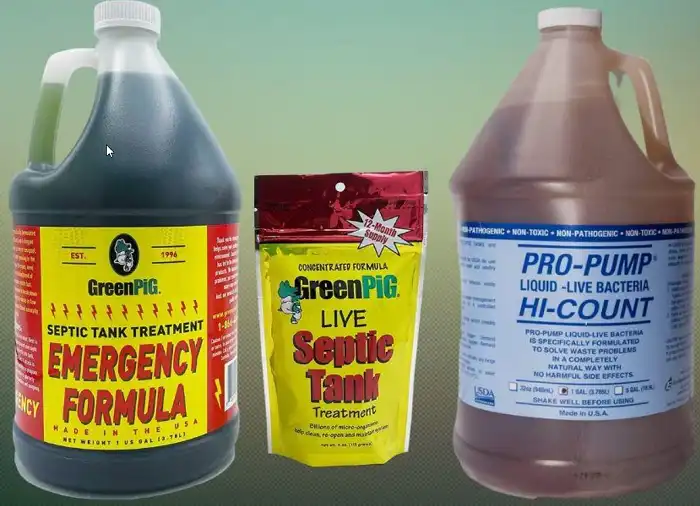
Options of a Wand or a Snake: Surprisingly, water alone can effectively clear a blocked RV toilet. Explore the market for RV-specific cleaning chemicals designed to flush out your black tank. Regular use not only helps in unblocking but also aids in maintaining a clean holding tank, ensuring proper functionality of tank sensors and a fresh-smelling interior post-emptying.
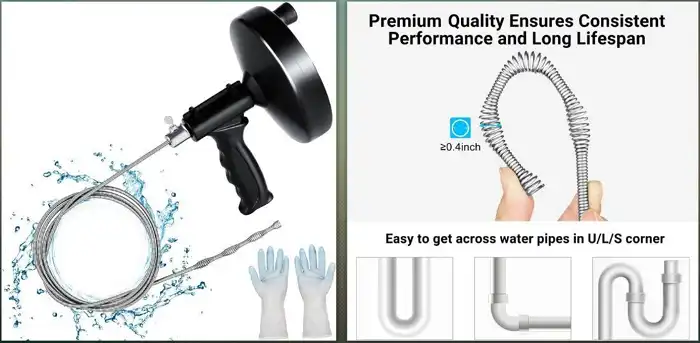
Fittings for Drain and Sewer Hoses: For those who prioritize effortless black tank maintenance, consider the user-friendly solution. Their drain and sewer hose fittings simplify the process of connecting your RV to a sewage line. The Rhino Blaster Tank Rinser, for instance, easily attaches to the RV’s drain, featuring a 45-degree angle that allows water to jet straight into the outlet, effectively clearing any buildup. The transparent elbow provides visibility, confirming the cleanliness of the water, while a vacuum breaker prevents water from being drawn back into the hose.
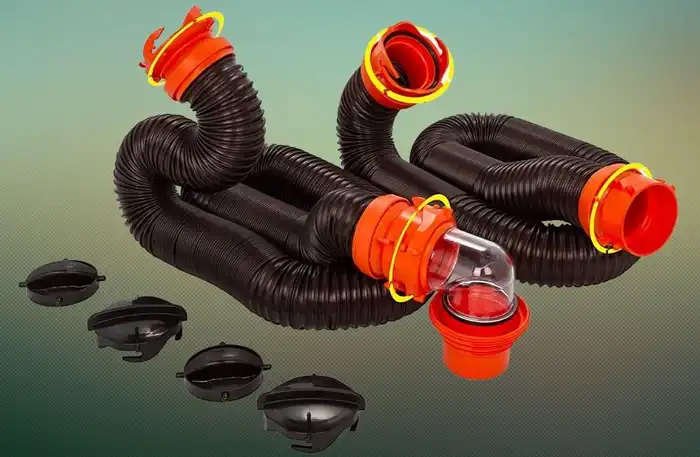
Keeping these essential products on hand ensures you’re well-prepared to tackle RV toilet clogs and maintain a hassle-free sewer system.
Common Causes of RV Toilet Clogs and How to Avoid Them
Before attempting to address a clogged black water holding tank and non-draining toilet, it helps to understand the common underlying causes of blockages:
Using too much regular toilet paper- Unlike special dissolving RV toilet paper, regular TP takes much longer to break down and disintegrate. Using too many sheets at once can quickly accumulate and clog inlet valves or drain pipes.
Dumping food waste or other trash down the toilet- Any non-waste items like food scraps, hygiene products, paper towels, etc can rapidly build up and form major obstructions. Most RV plumbing isn’t designed to handle anything beyond human waste and small amounts of TP.
Septic System Maintenance Products: Maintain a healthy septic system with specialized treatments containing beneficial bacteria. Break down solid waste, promote decomposition, and foster a balanced microbial environment to reduce issues like pyramid plugs.
Innovative Septic Tank Plugs: Invest in innovative septic tank plugs for efficient waste management, reducing the risk of pyramid plug formation. These advancements contribute to the long-term health and functionality of your septic system.
Natural Septic Remedies: Opt for natural septic remedies with bacterial additives for effective waste breakdown, preventing solid buildup and clogs. Choose environmentally friendly solutions for proactive septic system health.
Sensor Reading Challenges: Overcome septic system sensor challenges by checking for obstructions, performing regular calibration, and addressing issues promptly. Maintain efficiency and prevent complications for a smoothly operating system.
Addressing Tank Compaction Issues: Prevent septic tank compaction for optimal performance. Regular pumping, maintenance, and the use of treatments and additives ensure proper waste decomposition, contributing to system longevity and effectiveness.
Sewage tank discharge valves not opening fully- Output valves that don’t open fully due to wear/damage can get blocked easier by small accumulations of solid waste. Particles get stuck in valve openings preventing full closure.
Excessive use without tank discharge- Even with proper toilet paper and no foreign items entering the pipes, going too long without emptying can still lead to major build up and eventual clogs. Tanks should be drained regularly before reaching full capacity.
Damaged/deteriorating drain plumbing- Over time, aging pipes and connections can crack, separate, or develop internal obstructions that catch passing waste. Inspection for leaks or weakened areas can identify problems spots.
Step-by-Step Guide to Unclogging Your RV Toilet
Once the cause and location of a clogged black water tank or blocked drain line has been identified, the next step is clearing the obstruction so waste can freely flow again. Here are some tips:
Use a hand-crank auger snake- Snaking the drain lines with a spinning auger can help break up minor clogs or push more solid obstructions through the pipe out the outlet. Guide slowly and gently to avoid pipe damage.
Flush piping with water/air pressure- For inlet or mid-pipe clogs, quickly flushing large volumes of water from a hose or compressed air can help dislodge blockages.
Remove and clean black tank valves– If output valves are the root issue, unscrewing and physically removing them for cleaning or replacement will allow free drainage again.
Replace worn/damaged drain line sections- For aging/deteriorating pipe sections allowing debris accumulation, replacement with newer sturdy piping is needed to prevent recurrence.
Consult an RV plumbing specialist- For major, tricky, or recurring clog issues, consulting a professional plumber with RV expertise can be worth the cost to avoid frustration and ensure proper repair.
Budget-Friendly Solutions for RV Toilet Blockages
Dealing with a blocked black tank in your RV and don’t want to invest in specialized products? Here are some budget-friendly home remedies that you can easily try whenever and wherever needed.
1. Unclog your RV toilet inexpensively with boiling water. Bring it to a boil, cool briefly, and pour into the toilet. If your RV septic system is blocked, empty at least a gallon. Wait, then drain. Repeat as necessary, ensuring longer cooling for less sturdy setups.
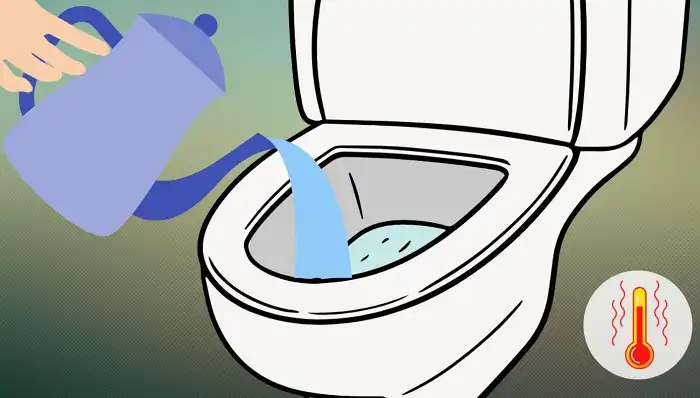
2. Running a drain auger snake into the tank inlet to physically break up and push blockages through the system is one of the most effective ways to clear tough clogs yourself without dismantling plumbing.
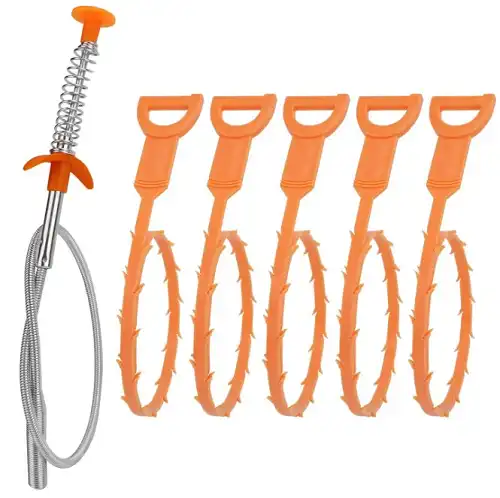
3. Attaching a high pressure nozzle to a garden hose and blasting water into the inlet can sometimes dislodge stuck debris with force and suck it out.
4. Pouring a whole box of baking soda followed by a gallon of vinegar into the bowl and allowing the fizzing chemical reaction work for 10-15 minutes uses bubbles to help loosen clogs.
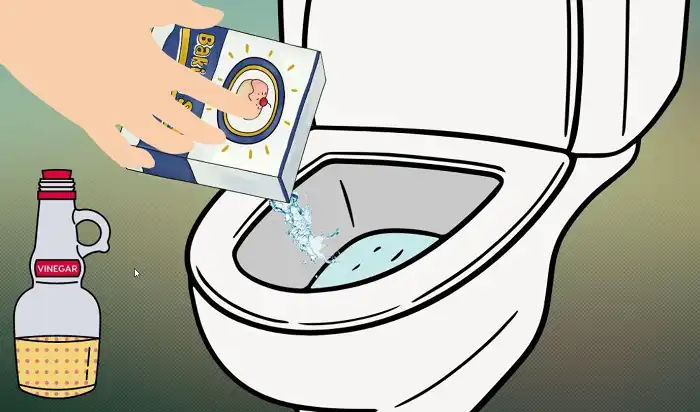
5. Clear RV toilet clogs affordably with dish soap or Vaseline. Add a bottle of dishwashing liquid or a few capfuls of detergent, let it settle, then drain. This preventive and practical measure acts as a lubricant, preventing solids from adhering to the tank’s interior.
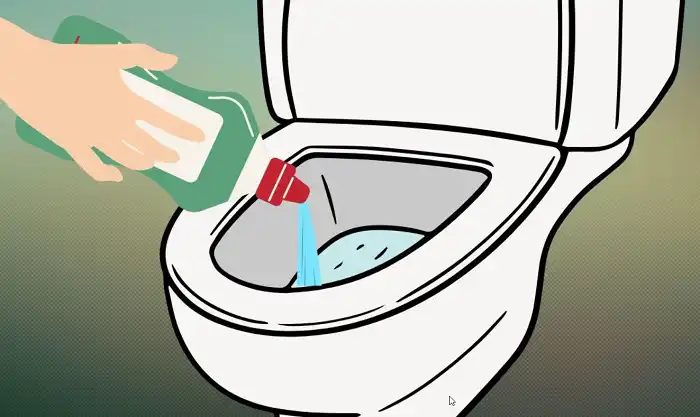
6. Revitalize your RV’s black tank inexpensively with the ice trick. Get a bag of ice, dump it in the black tank, close valves, and drive for 30 minutes. Return to the dump station, add water, and drain for an efficient, affordable solution to blockages.
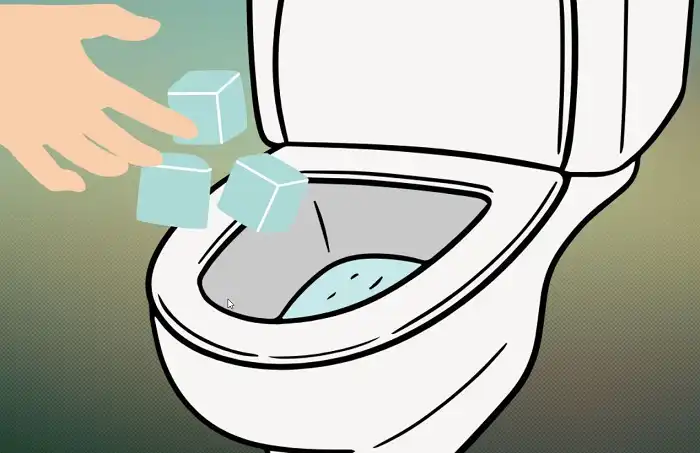
If DIY attempts fail to improve drainage, consulting an experienced mobile RV technician to bring more advanced tools like high-powered hydrojetters is likely required. As a last resort, removing piping or tank sections to clear extremely stubborn clogs manually may be needed.
How to Prevent Clogs in Your RV Toilet System
While occasional clogs can happen to anyone, there are tips RV owners can follow to help minimize how often toilet drainage issues occur:
Use specially designed RV toilet paper- These fast dissolving variants break down 5-10x faster to prevent accumulation around valves or in pipes compared to regular TP.
Install an in-line filter on output- Aftermarket filters attach near the outlet valve to catch stray solid particles before they get stuck and clog drainage exits. Just be sure to check and clear filters regularly.
Inspect and replace any old/damaged piping- Degraded plastic or rubber pipes can develop internal ridges that easily catch waste particles. Swapping with smooth, sturdy piping prevents this.
Only empty black tanks when mostly full- Letting a considerable waste volume accumulate helps create enough hydraulic pressure to push solids completely from tank to outlet.
Open/close outlet valve very slowly- Avoid abruptly popping open or slamming shut – controlled, gentle valve adjustment helps prevent suctioning nearby debris into valve openings before closure.
Use chemical treatments regularly- Enzyme/bacterial mixes liquefy solids and foaming cleansers help prevent buildup coatings inside tanks and plumbing.
Following these tips religiously makes it very unlikely clogs will occur except in extreme cases – and saves on expensive repairs or replacements down the road.
Questions and Answers (Q&A)
Q1: Why is my camper toilet full of water?
A: If the bowl fills higher than normal after flushing with no drainage, there is likely a clog in the waste line, caused by excess TP/waste buildup, popped plumbing joints, malfunctioning output valves, or other blockages.
Q2: How long do you flush an RV toilet?
A: 1-2 vigorous foot pedal pumps per flush are sufficient. Holding down for up to 5 seconds helps push solids into the tank without overflow. Anything longer may indicate an obstruction in the drainage system.
Q3: How do I unclog my RV black tank?
A: Use an in-tank wand with a blaster nozzle and hot soapy water. Fill the tank, let it soak, add RV enzymatic treatment, drive to agitate the solution, and power flush by opening/closing the valve repeatedly until drainage is clear.
Q4: Can you put vinegar in RV black tank?
A: Yes – a 50/50 mix of vinegar and hot water dissolves organic gunk, deodorizes, and breaks down waste. Let it sit for hours before draining. For tough buildup, alternate vinegar soaks with baking soda scrubs for fizzing reactions that break down clogs.
Summing Up
Clogged drainage from RV holding tanks leading to non-draining toilets is often just a matter of identifying and clearing simple obstructions. Using the right diagnostic steps pinpoints problem areas, and basic plumbing tools combined with proper clearing methods readily resolve many clogs. Preventing blockages in the first place via RV toilet paper, additives, and careful black tank management also reduces headaches down the road. Discussing specific issues with a professional mobile RV technician can provide additional troubleshooting and expertise for the most stubborn drainage failures.



Наш сервис способен найти данные о любом человеке .
Достаточно ввести имя, фамилию , чтобы сформировать отчёт.
Бот сканирует публичные данные и цифровые следы.
глаз бога найти по номеру
Результаты формируются в реальном времени с фильтрацией мусора.
Идеально подходит для анализа профилей перед сотрудничеством .
Анонимность и точность данных — гарантированы.
Your comment is awaiting moderation.